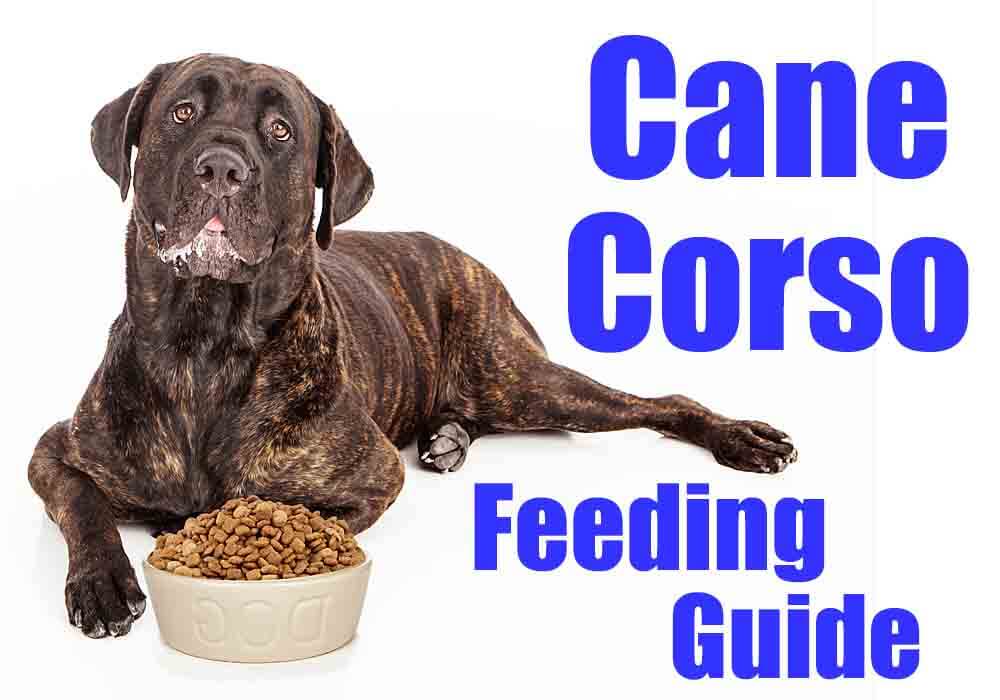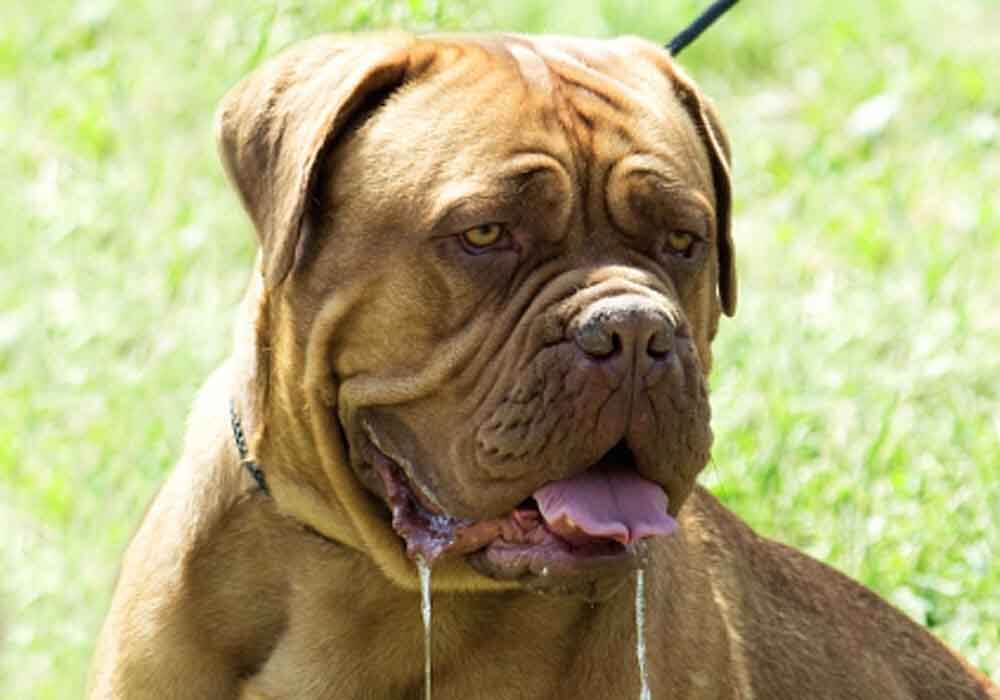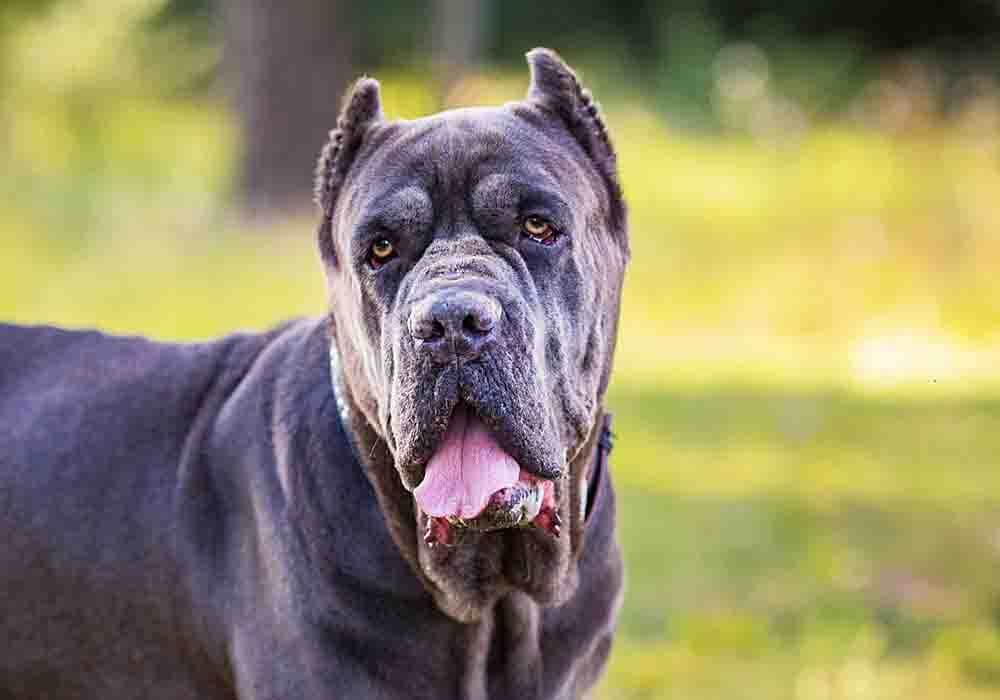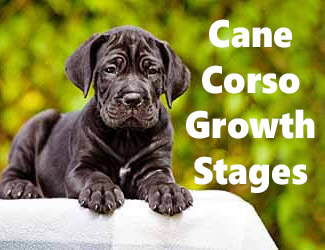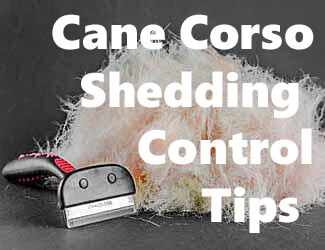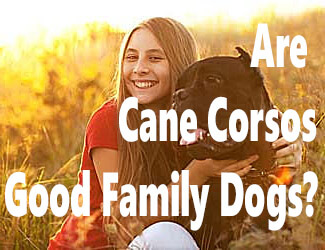Cane
Corso Breed Information
History, Characteristics, Purpose
by Ken Alden
Cane Corso Mastiffs are not one of the
most popular or well-known breeds in the world, but this large war dog has a
pedigree that goes back centuries. Chances are if you ever get a chance to see one up close, you’ll never forget it.
What Is A Cane Corso...
A Cane Corso is a breed of Italian Mastiff that is descended from the war dogs used in ancient Rome. These large, imposing dogs are formidable guards of the home and family but are also good-natured companions. This dog is the 40th most popular breed of dog in the United States and the most searched breed in all of Europe.
While these are impressive animals, they aren't the best dog for everyone. Read on to find out more about these war dogs and whether they'd be right for your home. Read More Below...
Pro-tip: Ever try lifting a Cane Corso? Their weight can hurt not only your back but their joints when they hop down from cars, sofas or even your bed. To protect your back and theirs check out the best Mastiff ramps on Amazon.com now.
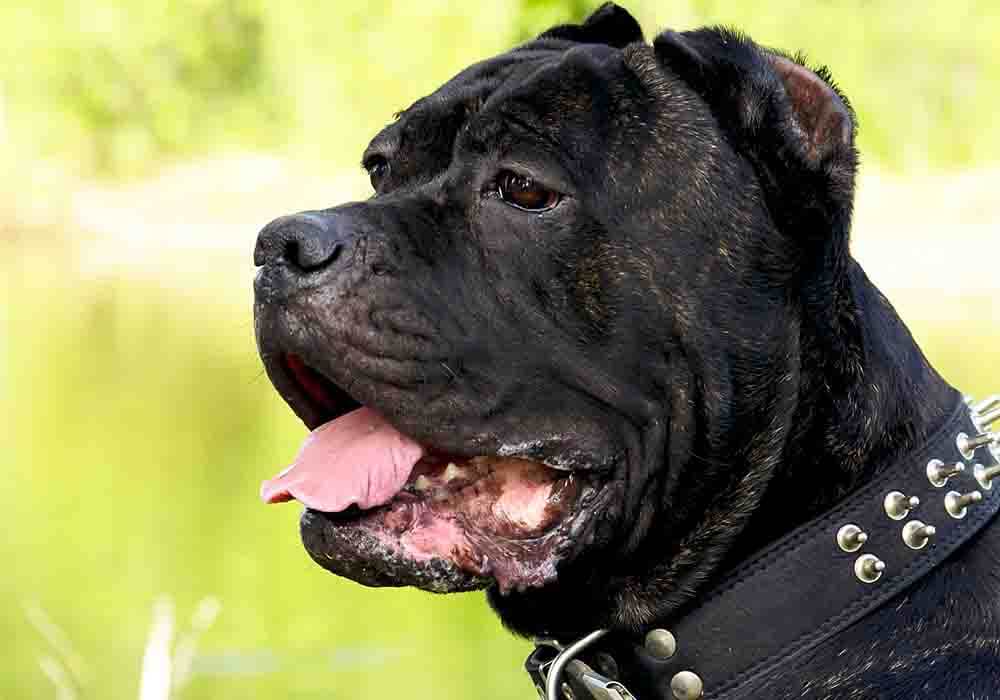
History of the Cane Corso
This dog might have only recently regained some of the popularity it enjoyed in ancient times, but this dog of war has been around for a long, long time. Originally used by the Romans in their conquest of the known world, once Rome collapsed, these dogs were repurposed as guardians of the home and field, as well as livestock protectors.
The name Cane Corso roughly translates to "bodyguard dog," and the fearless nature of the breed reflects this tradition. While they were once used on the vanguard of the Roman lines, the Cane became well-known for protecting farmers from ill-tempered wild boar or driving large, powerful cattle to slaughter.
Because
they are as gentle towards family as they are aggressive towards intruders,
many Cane Corsos transitioned to "yard dogs," designed to protect (or
in many cases, simply deter through their size and appearance) a country estate
from trespassers.
By the 1970s, they had become so
uncommon that it was on brink of extinction as a breed. A large part of this
was due to being decimated in WWII. But thanks to renewed efforts to invigorate
the gene pool of the Cane Corso by several breeders, it has now become more
popular and is being seen more often as a pet rather than just a show or
working dog.
Is a Cane Corso a Mastiff?
Though many people refer to a Cane Corso as a mastiff and this isn't incorrect, it also isn't entirely accurate. More than a mastiff this dog is considered a "molosser," which is a large, heavy breed of dog with short pendant ears and a smooth coat which is bred for property guarding, hunting, and blood sports (either dogfighting or war).
This makes molosser breeds like this distinctive in function from many large breeds of dogs that are called mastiffs but are actually livestock guardian breeds, such as the Tibetan mastiff. As a result of the confusion between the two working dog classes, there have been efforts to recognize this breed and other mastiff breeds like it as molosser dogs in order to preserve the distinction between their show class and the show class of livestock guardian mastiffs.
Most laymen walking down the street, however, are going to call a Cane Corso a mastiff if they see it, and they wouldn’t be wrong. They possess the large, powerful body builds, short-cropped ears, and wide muzzles that typically denote a mastiff breed.
The
two main types of mastiff originating from Italy are the Cane Corso and the
Neapolitan Mastiff. They are most notably different in appearance through the
look of their skin and jowls—Neapolitan Mastiffs are a breed of dog with large
sagging jowls and folds of wrinkled skin across their bodies somewhat similar
to a Sharpei, while Canes have a much tighter presentation and smoother
face like the English Bullmastiff.

This breed has a fascinating history as to why they were bred in the first place. Read this page of ours to learn all about it.
Quick Fact...What does the name Cane Corso mean?
Cane: This word is Italian for dog
Corso: This relates to the Latin cohors, "guardian"
So loosely put, it means Guardian Dog
What Breeds Were Used to Create the Cane Corso?
This is such an old breed of dog that the dogs used to create it did not really have official breeds—these were the Greek war dogs of the Molossi. The closest the Molossi dogs had to a breed was the Molossus of Epirus, a pure Greek breed that was originally used for livestock guardianship then was repurposed as a war dog in the battle against the Romans.
These ancient dogs are thought to be the origin of most European mastiff breeds. Since they traveled with the Roman legions, these dogs ended up from one end of the continent to the other, and dog breeds that vaguely resemble the ancient Molossus of Epirus can be found throughout what were once the tribute states of the Roman Empire.
The Romans procured these dogs as spoils of conquest when they overtook the Greeks and made them their own. By the time they were done tweaking them to Roman specifications, they had come out with the two Italian war dog breeds, the Cane Corso and the Neapolitan Mastiff.
At
this point, there was little of the Cane Corso’s livestock guarding role left
in its working background, and it had been transitioned almost completely into
a dog of war trained to guard and defend humans rather than animals.
Cane Corso Appearance
Like most molosser type dogs, this dog is known best by their intimidating appearance. These dogs possess a broad chest, powerful muscles, a large square head, and a wide muzzle full of teeth designed to scare off even the boldest warrior.
As with many mastiffs, Canes have a short slick coat that can come in several different colors, but they are most often found in the following show-accepted colors:
- Black
- Gray (all shades)
- Red
- Fawn
- Brindle
The two major disqualifications for a Cane in show regarding its appearance include black-and-tan markings in the coat, and yellow eyes (bird of prey) or blue eyes.
Yellow
eyes are generally discouraged in estate guardian dogs such as mastiffs or
Great Danes because they give the dogs an unfriendly look about them that is
threatening to guests. Blue eyes are discouraged in many breeds of dog because
they are associated with deafness and other congenital health problems.
Pro-tip: Cane Corso anxiety, aggression, destructive chewing, jumping up, fearfulness, and other behaviors can be controlled with the right training program.
Here’s a great course that
addresses these issues along with many other dog training basics: Check it out now!
Cane Corso Temperament
As noted before, this is a fiercely loyal breed of dog, and it has been bred this way for a reason, hence the name "bodyguard dog." Whichever person this dog bonds with will typically have the dog’s loyalty for all its life.
This trait worked against the them during WWII, when many Italian men went off to war, and those left behind were sometimes unable to handle or control these powerful dogs without their masters to calm them. When they are raised around a family and bond with everyone equally, however, they quickly become a member of the family themselves.
A drawback to this temperament is that while it is affectionate with family members and its master, it is sometimes aggressive to anyone outside of the family circle. Because they are bred to deter strangers from its people, this can be a very difficult trait to train out of a dog when it presents as a behavior.
This
means that someone who acquires one needs to be respectful of the
power this breed is capable of and needs to be willing to commit a lot of time
to making sure the dog is properly socialized and trained. With regards to
intelligence, these dogs are easily among the most intelligent and
trainable of the mastiff breeds, though they can be prone to impulsive behavior
(especially during adolescence).

So are Cane Corsos a good protection or security dog? Do they have the temperament to do this sort of job?
Are Cane Corso Good Family Dogs?
Despite their formidable approach towards strangers and trespassers, Cane Corsos can be very good family dogs when they are properly socialized and trained around every member of the family. In fact, if you raise a puppy intensively around its family, you’re not likely to find a dog that is more loyal to the household.
Because of their power and size, anyone who has children must teach the children to respect their dog. While they can be very affectionate and gentle towards children, a Cane will not readily tolerate physical abuse, and a child who either deliberately or accidentally hurts one of these dogs is likely to end up badly mauled.
The best way to make sure that they remain friendly to all members of the household is to expose and socialize them as puppies very
early to all sorts of people and animals.
The more exposed a dog is during puppyhood to these types of stimuli, the less
reactive they are, and the less chance there is that they will become
aggressive as a kneejerk reaction to a situation.

This helpful article of ours goes more in depth about the Cane Corso as a family dog if you're thinking of bringing one home.
Are Canes good with kids and babies? This should be a vital read if you wonder how safe this dog is to be around.
Are Cane Corso Dogs Dangerous?
There’s no doubt about it—Cane Corso dogs have the potential to be very dangerous, even deadly. This is the direct result of their breeding as Roman war dogs. A dog that has been bred to carry flaming buckets of oil to smash into the enemy lines is not going to be easily deterred once it goes into an aggressive frame of mind and starts attacking someone.
The sheer weight and size of these dogs alone make them dangerous when aggressive, and Cane Corsos have a very high pain tolerance. This means that if your dog attacks another dog or a person, it is going to be difficult or impossible to beat the dog off until it’s good and ready to stop. These dogs also have a high prey drive, which can make them lethal to cats or small dogs if they aren’t socialized.
The Cane has a bite strength of 700 pounds per square inch (psi). To put it in terms the layman can understand, that is stronger than the bite of a lion, which comes in at only 650 psi. To say that a Cane Corso could easily kill a person it disagreed with is a serious understatement. Small children and the elderly are even more at risk against such a powerful animal if it isn’t under control.
Despite
their lethal potential, at the end of the day, a dog is only as dangerous as
its master's lack of training, so a well-trained and well-socialized Cane is no more dangerous than any other large breed dog. But anyone wanting to own
one of these dogs should be aware of their potential, and no person should
undertake guard dog training with a Cane Corso unless they are a trained
professional.

Want to learn more about just how aggressive or dangerous Cane Corso's can be? This article of ours covers it all.
Cane Corso Health
Like many large purebred dogs, the Cane Corso is susceptible to several congenital health issues. These issues are more prominent in Canes than some other breeds due to the explosive popularity of the breed in recent years (leading to sloppy backyard breeding practices with no regard for Cane Corso temperament or appearance standards) and because of the small gene pool of this once-rare dog.
Here are some of the congenital health problems you might run into if you buy or adopt a Cane Corso:
- Hip dysplasia: Hip dysplasia is a congenital skeletal issue that is common
in many purebred working dog breeds. This painful condition is where the ball
of femur does not fit correctly into the joint of the pelvis, eventually
leading to the dog losing its ability to walk.
Large breed dogs are more susceptible to hip dysplasia as a result of how quickly large breed puppies grow. To avoid getting a dog with hip dysplasia, make sure you purchase from a breeder who screens for the condition. - Entropion/ectropion: Entropion and ectropion are disorders of the eyelid, where the eyelid either curls inward or
outward. This is very uncomfortable for the dog and can even lead to corneal
ulceration or blindness in extreme cases. Dogs with drooping faces such as
hounds and mastiffs are more predisposed to eyelid-related issues than other
breeds.
- Demodectic mange: Demodectic mange is caused by a mite
infestation, and mastiff breeds are often susceptible to mites due to their
very short coats. Also known as red mange,
this skin condition is transmissible to humans and can cause secondary skin
infections and lesions.
- Gastric torsion (bloat): Gastric torsion (or bloat) is another type of serious medical condition that is common in large dogs. Most commonly caused by a large breed dog swallowing excessive amounts of air while eating or drinking too quickly, gastric torsion can lead to the stomach flipping over and cutting off blood supply to vital organs.
Even when treated by a vet, the mortality rate for bloat is 10-60%, so most large breed owners take steps to prevent bloat by slowing down how quickly their dogs eat, feeding dogs more than once a day, and restricting food and water intake after strenuous exercise.
These dogs have a high pain tolerance, so if you own one, it's important that
you periodically check the dog over for cut pads, puncture wounds, or other
injuries that the dog may not favor to the point that you would notice
otherwise.
Nutrition for Growing Cane Corso Puppies
As mentioned briefly in the previous section, incorrect nutrition for Cane Corsos can lead to several serious issues like bloat and hip dysplasia, so it's important that when they're growing, that Cane Corsos are given the proper amounts and types of food to keep them healthy.
Large breed puppies grow quickly, and these massive growth spurts can lead to bone abnormalities and other problems. To avoid this, owners need to feed their Cane Corso puppies a diet that is formulated for large breed puppies, provide food several times a day to deter puppies from overeating in a single sitting, and have their growth monitored to make sure that they aren’t growing too fast.
Large
breed puppies should typically receive a diet with about 30% protein and 9%
fat, with a calcium content of roughly 1.5%. It's important that a puppy
receives more protein than calcium, as bones that grow rapidly are less dense,
and the puppy needs plenty of protein to develop the muscular system necessary
to support its skeletal frame and avoid orthopedic injury properly.
Pro-tip: Cane Corso's (and their owners) love dog crates…and for good
reasons. Crates keep dogs from mischief while you're away, are perfect for house
training, for traveling by car, and provide the dog a place to de-stress. Check
out the best Mastiff crates on Amazon.com now.
Cane Corso Lifespan
Like many large breed dogs, Cane Corsos, unfortunately, do not live to be as long as some smaller breeds, though they do live a bit longer than some of the giant breed types like Great Danes or Irish Wolfhounds. The average lifespan of a Cane Corso runs a little bit over nine years.
This means that Cane Corsos and other mastiffs are not as quite long-lived as some of the other popular large breeds such as Golden Retrievers, but with proper veterinary care and nutrition, these dogs can live a long healthy life.
In
recent years, there have been studies of this dog’s lifespan in order to
try and increase the longevity of the breed
through appropriate breeding programs. Unfortunately, due to their history as a
pure working dog or dog of war where the dog’s lifespan was expected to be cut
short due to its violent lifestyle, longevity was never a trait that was
deliberately bred into Cane Corsos until modern times.
Cane Corso Grooming
The Cane Corso dog has a naturally short, sleek single coat, which means that they’re a lot less time-consuming to groom than many large breed dogs of equivalent size with a double coat. These short coats are designed to keep the dog cool during the scorching Italian summers and make it easier to find and treat the dog’s wounds after a battle.
For regular grooming, the most a Cane Corso will need is a good rigorous bath and a nail clipping every month or so. It is important that a Cane puppy be taught to tolerate grooming activities from a young age (and even enjoy them through positive reinforcement) so that grooming doesn't become a battle of wills between you and your dog.
Each week a Cane Corso’s coat should be brushed through with a curry brush to remove any dead hairs, its nails should be kept clipped, and the ears should be wiped down and checked for smells or discharge that would indicate an infection.
This
is especially important if the dog goes into the water at all, as dogs can
develop ear infections after swimming, just like people can, and Cane Corsos
are typically stoic in the face of pain. That means it’s important for owners
to check them over and make sure they aren’t injured. Regular grooming time is
a good time for owners to both bond with their Cane Corso while inspecting them
for illness or injury.
Cane Corsos Need Stimulation
Cane Corso dogs are one of the most intelligent mastiff breeds, and this makes them easily trainable. However, these headstrong dogs can be a handful if they become bored or begin to suspect that their master is not worthy of respect. Without a specified job given to them, many Canes will also fall back on their genetic career, which is to scare the daylights out of anyone who comes into your yard.
When they lack stimulation, Cane Corsos can also turn to destructive activities such as digging or damaging property. The best way to prevent a Cane Corso from acting out in this way, especially during adolescence, is to make sure the dog has something to do.
The following are ways to help provide
stimulation to Cane Corsos:
- Exercise:
Unlike some large breed dogs which are content to lay around the house, these dogs are athletes that require plenty of strenuous activity to remain
engaged. This is not a breed of dog for couch potatoes. Regular daily walks and
hiking trips are essential to keep these dogs in their best form and to keep
them from going stir crazy at home.
- Obedience training: Obedience training is an absolute must for
owning a Cane Corso or any other large breed of dog since these breeds are
dangerous if they are not under the complete control of their owners. But
obedience training also stimulates a dog’s mind and gives it an outlet for
communicating with its owner; this can help strengthen the bond between the two.
- Enrichment toys: There are many treat puzzles and other toys
that are designed to keep dogs intellectually entertained, and Cane Corsos need
plenty of them in order to help keep themselves occupied. This is especially
true if the dog is left unattended for long periods of time, as Cane Corsos can
become neurotic when separated from their bonded owner.
Cane Corso dogs are not a breed of dog that you can buy and then just throw in your backyard (though you shouldn’t do that with any breed of dog). These are powerful, highly intelligent animals that must be actively worked with in order to be affectionate and safe members of the household.
Because they can be naturally aggressive towards outsiders as an innate part of
their temperament, it is the responsibility of the owner to make sure that they
don’t develop a habit of attacking unfamiliar house guests, meter men, or other
visitors to the property.
Cane Corsos and Breed Bans
Due to their imposing size and
background, Cane Corsos are one of the breeds of dogs that are most frequently
the targets of breed-specific dog bans in housing. This means that if you live
in an apartment with breed-specific dog bans that involve the Cane Corso, it is
in violation of your lease to possess that breed of dog on the property.
Cane Corsos face breed bans
in cities in the following American states:
- Arkansas
- Colorado
- Idaho
- Kansas
- Nebraska
- Oregon
- South Dakota
- Washington
Whether these breed bans are fair or not is up for debate, but the important thing to remember is that if you live in one of these states, you should check with local animal control regulations before you consider adopting or purchasing a Cane Corso.
Another reason that Canes are often banned, especially in public housing such as apartment complexes, is that they closely resemble some other banned breeds such as pit bulls to those who aren’t familiar with dogs.
This prevents people with pit bulls
from being able to claim that their dog is a Cane Corso mix or some other breed
to avoid being banned from housing. For many private property owners, it is far
simpler just to ban both breeds altogether.
Cane Corsos Are Good Dogs for the Right Owner
It’s hard to find a dog with a more illustrious past than the Cane Corso. From guarding ancient Roman military commanders to protecting Italian farmsteads, this ancient breed is one you wouldn’t readily forget if you ever saw it walking down the street.
If
you’re looking for a large breed dog that is both fiercely loyal and
intelligent enough to be trained, a Cane Corso is right up your alley. But it’s
important to always keep in mind the requirements for socializing and training
this powerful animal in order to prevent it from becoming a danger to the
public.
Return to the top of this Cane Corso page

About the Author...
Ken Alden, a dedicated Mastiff owner for over eight years, is acclaimed for his expertise in care, grooming, and training. Read more About Me and my dog Shadow.
- Mastiff Guide Home ›
- Cane Corsos ›
- Cane Corso Breed Information
